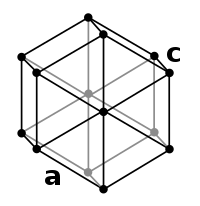
Data Driven Determination of Reaction Conditions in Oxidative Coupling of Methane via Machine Learning
Sign Up to like & getrecommendations! Published in 2019 at "ChemCatChem"
DOI: 10.1002/cctc.201900843
Abstract: The challenge in catalytic reactions lies within its complexity coming from high dimensional experimental factors. In order to solve such complexity, machine learning is implemented to treat experimental conditions in high dimensions. Oxidative coupling of… read more here.
Keywords: machine; machine learning; coupling methane; experimental conditions ... See more keywords

Analysis of Updated Literature Data up to 2019 on the Oxidative Coupling of Methane Using an Extrapolative Machine‐Learning Method to Identify Novel Catalysts
Sign Up to like & getrecommendations! Published in 2021 at "ChemCatChem"
DOI: 10.1002/cctc.202100495
Abstract: We have constructed and analyzed an updated dataset consisting of 4759 experimental datapoints for the oxidative coupling of methane (OCM) reaction based on literature data reported before 2020 (∼2019) using machine learning (ML) methods. Several… read more here.
Keywords: coupling methane; machine learning; oxidative coupling; literature data ... See more keywords

In search of membrane-catalyst materials for oxidative coupling of methane: Performance and phase stability studies of gadolinium-doped barium cerate and the impact of Zr doping
Sign Up to like & getrecommendations! Published in 2018 at "Applied Catalysis B: Environmental"
DOI: 10.1016/j.apcatb.2018.02.040
Abstract: Abstract Oxidative coupling of methane (OCM) is a promising technology for the direct conversion of methane to ethylene and ethane (C2). This process is yet to be commercialized due its poor yield reflected in the… read more here.
Keywords: phase; methane; coupling methane; oxidative coupling ... See more keywords

Combined experimental and density functional theory (DFT) studies on the catalyst design for the oxidative coupling of methane
Sign Up to like & getrecommendations! Published in 2019 at "Journal of Catalysis"
DOI: 10.1016/j.jcat.2019.04.008
Abstract: Abstract Catalytic descriptors were studied to design optimum catalysts for the oxidative coupling of methane (OCM) by combining density functional theory (DFT) calculations and actual reaction experiments. SrTiO3 perovskite catalysts, selected for OCM, were modified… read more here.
Keywords: theory dft; density functional; oxidative coupling; coupling methane ... See more keywords

Adsorption separation of oxidative coupling of methane effluent gases. Mini-plant scale experiments and modeling
Sign Up to like & getrecommendations! Published in 2019 at "Journal of Natural Gas Science and Engineering"
DOI: 10.1016/j.jngse.2018.11.007
Abstract: Abstract This work explored the use of a zeolite molecular sieve as adsorbent material in the separation of effluent gases from an oxidative coupling of methane (OCM) process. The molecular sieve granules were synthesized, characterized,… read more here.
Keywords: separation; adsorption; effluent gases; oxidative coupling ... See more keywords

Screening of single and binary catalysts for oxidative coupling of methane to value-added chemicals
Sign Up to like & getrecommendations! Published in 2019 at "Molecular Catalysis"
DOI: 10.1016/j.mcat.2019.03.021
Abstract: Abstract A combinatorial approach was applied to explore active binary catalysts for oxidative coupling of methane (OCM) to value-added hydrocarbons (C2+). A screening of 25 selected single components on SiO2 for OCM reaction identified the top-14… read more here.
Keywords: catalyst; methane; oxidative coupling; coupling methane ... See more keywords

X-ray absorption fine structure studies on nickel phosphide catalysts for the non-oxidative coupling of methane reaction using a theoretical model
Sign Up to like & getrecommendations! Published in 2021 at "Radiation Physics and Chemistry"
DOI: 10.1016/j.radphyschem.2021.109727
Abstract: Abstract SiO2-supported Ni phosphide catalysts are highly active toward the non-oxidative coupling of methane (NOCM) reaction, and their catalytic activity is strongly dependent on their Ni:P ratio. We analyzed Ni phosphide catalysts using X-ray absorption… read more here.
Keywords: non oxidative; phosphide catalysts; structure; coupling methane ... See more keywords

C–H Bond Activation and C–C Coupling of Methane on a Single Cationic Platinum Center: A Spectroscopic and Theoretical Study
Sign Up to like & getrecommendations! Published in 2022 at "Inorganic Chemistry"
DOI: 10.1021/acs.inorgchem.2c01328
Abstract: We spectroscopically investigated the activation products resulting from reacting one and multiple methane molecules with Pt+ ions. Pt+ ions were formed by laser ablation of a metal target and were cooled to the electronic ground… read more here.
Keywords: activation coupling; bond activation; product; coupling methane ... See more keywords

Highly Durable C2 Hydrocarbon Production via the Oxidative Coupling of Methane Using a BaFe0.9Zr0.1O3−δ Mixed Ionic and Electronic Conducting Membrane and La2O3 Catalyst
Sign Up to like & getrecommendations! Published in 2021 at "ACS Catalysis"
DOI: 10.1021/acscatal.0c04888
Abstract: The oxidative coupling of methane (OCM) is an attractive technology for the production of ethane (C2H6) and ethylene (C2H4); and significant performance and efficiency gains as well as reduced carb... read more here.
Keywords: durable hydrocarbon; production; oxidative coupling; coupling methane ... See more keywords

Effects of Mg, Ca, Sr, and Ba Dopants on the Performance of La2O3 Catalysts for the Oxidative Coupling of Methane
Sign Up to like & getrecommendations! Published in 2022 at "ACS Omega"
DOI: 10.1021/acsomega.1c04738
Abstract: Oxidative coupling of methane (OCM) is a reaction to directly convert methane into high value-added hydrocarbons (C2+) such as ethylene and ethane using molecular oxygen and a catalyst. This work investigated lanthanum oxide catalysts for… read more here.
Keywords: catalyst; coupling methane; oxidative coupling; methane ... See more keywords

Codoping Mg-Mn Based Oxygen Carrier with Lithium and Tungsten for Enhanced C2 Yield in a Chemical Looping Oxidative Coupling of Methane System
Sign Up to like & getrecommendations! Published in 2021 at "ACS Sustainable Chemistry & Engineering"
DOI: 10.1021/acssuschemeng.0c07241
Abstract: Oxidative coupling of methane (OCM) is a compelling strategy for the direct conversion of methane to C2+ hydrocarbons in order to produce fuels and value-added chemicals. Nevertheless, it remains c... read more here.
Keywords: oxygen carrier; methane; coupling methane; oxidative coupling ... See more keywords